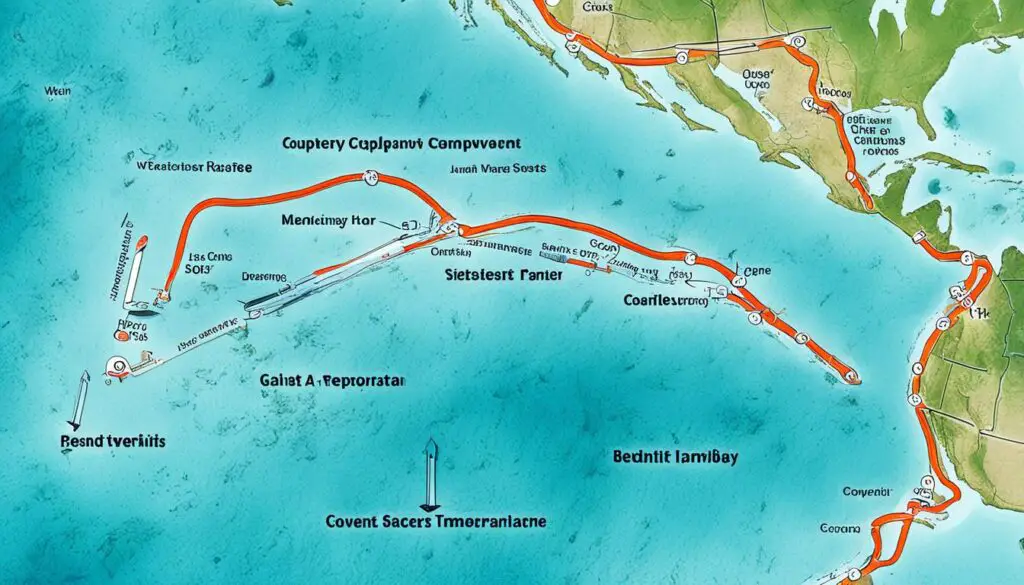Greetings, fellow scuba diving enthusiasts! Today, I want to take you on an extraordinary underwater adventure that goes beyond the depths we’re used to. Brace yourself as we delve into the fascinating world of altitude diving above 300 meters!
Altitude diving, as the name suggests, involves exploring underwater wonders at altitudes above 300 meters or 1000 feet. This thrilling form of scuba diving offers a unique challenge for adventurers seeking new depths and untouched aquatic landscapes. But before we plunge into the depths, let’s delve into the crucial details and considerations to ensure a safe and exhilarating experience.
Key Takeaways:
- Altitude diving allows scuba divers to explore underwater ecosystems at altitudes above 300 meters or 1000 feet.
- There are unique challenges and considerations associated with diving in high-altitude conditions.
- Altitude sickness, caused by low oxygen levels, is a significant concern when diving above 300 meters.
- Proper dive planning, specialized equipment, and safety measures are essential for altitude diving.
- With careful preparation and adherence to safety guidelines, divers can enjoy the wonders of altitude diving while minimizing risks.
Understanding the Effects of Altitude on the Body
When diving at an altitude above 300 meters, one of the main concerns is altitude sickness, also known as acute mountain sickness (AMS). Altitude sickness is caused by the lower amounts of oxygen available at higher altitudes, resulting in various symptoms such as headaches, nausea, dizziness, and shortness of breath. The body needs time to acclimatize to the lower oxygen levels, so it is important to ascend slowly and allow for proper acclimatization before engaging in any physical activity, including diving.
Altitude sickness occurs due to the reduced atmospheric pressure at higher altitudes, resulting in a decrease in the amount of oxygen available to the body. As a result, the body may struggle to adjust to the low oxygen levels, leading to uncomfortable and potentially dangerous symptoms. It is crucial to recognize and understand the signs of altitude sickness to ensure safe diving practices.
Some of the common symptoms of altitude sickness include:
- Headaches
- Nausea and vomiting
- Dizziness
- Shortness of breath
- Loss of appetite
- Fatigue
If any of these symptoms develop during a dive or ascent to higher altitudes, it is important to immediately descend to a lower altitude and seek medical attention if necessary.
Altitude sickness can affect anyone, regardless of age or fitness level. It is essential to prioritize safety and take the necessary precautions to prevent and manage altitude sickness while diving.
Acclimatization is a key process in preparing the body for altitude diving. By gradually exposing the body to higher altitudes, the body can adjust to the changes in oxygen levels and reduce the risk of altitude sickness. Planning for adequate acclimatization time is critical before engaging in any physical activity, including diving. It is recommended to spend at least 24 to 48 hours at an intermediate altitude to allow the body to adapt before ascending further.

During the acclimatization period, it is important to listen to your body and take things slowly. Avoid strenuous activities and allow yourself time to rest and recover. Hydration is also crucial in supporting the acclimatization process, so be sure to drink plenty of water throughout the day.
Understanding the effects of altitude on the body and the importance of acclimatization is vital for safe and enjoyable altitude diving. By taking the necessary precautions, divers can minimize the risk of altitude sickness and fully appreciate the wonders of diving at higher altitudes.
Tips for Altitude Diving Above 300 Meters
When planning a dive at an altitude above 300 meters, proper dive planning, equipment considerations, and safety measures are vital. Here are some important tips to keep in mind to ensure a safe and enjoyable altitude diving experience:
- Dive Planning: Ensure clear communication with your dive buddies or dive operator. Familiarize yourself with the dive site, including potential hazards and emergency procedures. By having a well-defined plan, you can mitigate risks and enhance your overall diving experience.
- Equipment Considerations: When diving at higher altitudes, specialized equipment becomes essential. Dive computers that can adjust for altitude provide accurate readings and help you stay within safe diving limits. Additionally, regulators designed for low-oxygen environments ensure a consistent and reliable air supply throughout your dive.
- Safety Measures: Prioritize safety at all times during altitude dives. Maintain proper buoyancy control to prevent rapid ascents or descents. Regularly monitor your air supply to avoid running out of air unexpectedly. Conducting safety stops during ascent allows your body to off-gas safely. Always be aware of your surroundings and conserve energy for a safe return to the surface.
By incorporating these dive planning strategies, equipment considerations, and safety measures, you can confidently explore the wonders of altitude diving above 300 meters while minimizing potential risks.

Stay Prepared with Essential Altitude Diving Gear
| Equipment | Description |
|---|---|
| Dive Computers with Altitude Adjustment | These dive computers automatically adjust for altitude, providing accurate readings and dive profiles tailored to the high-altitude environment. |
| Altitude-Optimized Regulators | Regulators designed for low-oxygen environments ensure consistent airflow and reliable performance in altitude diving conditions. |
| Surface Marker Buoys (SMBs) | SMBs are crucial for signaling your position on the surface and are especially important when diving in areas with surface boat traffic. |
| High-Visibility Dive Flags | These flags provide increased visibility to boats and other watercraft, alerting them to the presence of divers below. |
Conclusion
Altitude diving above 300 meters can be a thrilling adventure, providing divers with unique opportunities to explore the underwater world in high-altitude locations. However, safety should always be a top priority when embarking on altitude diving journeys.
Proper dive planning is crucial to ensure a safe and successful dive. By thoroughly researching the dive site, assessing potential hazards, and communicating with dive buddies or operators, divers can minimize risks and make informed decisions during their altitude diving experiences.
Acclimatization plays a vital role in altitude diving safety. Allowing your body enough time to adjust to the lower oxygen levels ensures optimal physical performance and reduces the risk of altitude sickness. Ascending slowly and gradually, while closely monitoring your body’s response, is essential for a safe and enjoyable dive.
Equipping yourself with the right gear is another key aspect of altitude diving safety. Dive computers that account for altitude and regulators suitable for low-oxygen environments are recommended. And, as always, maintaining proper buoyancy control, monitoring your air supply, and following established safety procedures are imperative for a secure diving experience.
In conclusion, altitude diving above 300 meters can be a remarkable endeavor for experienced divers. By prioritizing dive planning, understanding the effects of altitude on the body, and taking necessary safety measures, divers can delve into the wonders of altitude diving while ensuring their own well-being. With proper preparation and a focus on safety, altitude diving can deliver unforgettable underwater adventures.
Remember: Dive responsibly, be knowledgeable, and enjoy the beauty of altitude diving with safety as your top concern!
FAQ
What is altitude diving?
Altitude diving refers to diving at an altitude above 300 meters or 1000 feet, presenting unique challenges due to changes in atmospheric conditions.
What is altitude sickness?
Altitude sickness, also known as acute mountain sickness (AMS), is caused by lower oxygen levels at higher altitudes, resulting in symptoms such as headaches, nausea, and shortness of breath.
How can I prepare for an altitude dive?
Proper dive planning, communication with dive buddies or operators, acclimatization, and using specialized equipment for altitude diving are important steps to prepare for an altitude dive.
What specialized equipment do I need for altitude diving?
Consider using dive computers that can adjust for altitude and regulators suitable for low-oxygen environments when diving at higher altitudes.
What safety measures should I follow during an altitude dive?
Prioritize safety measures such as proper buoyancy control, monitoring air supply, and conducting regular safety stops to ensure a safe and enjoyable altitude diving experience.
